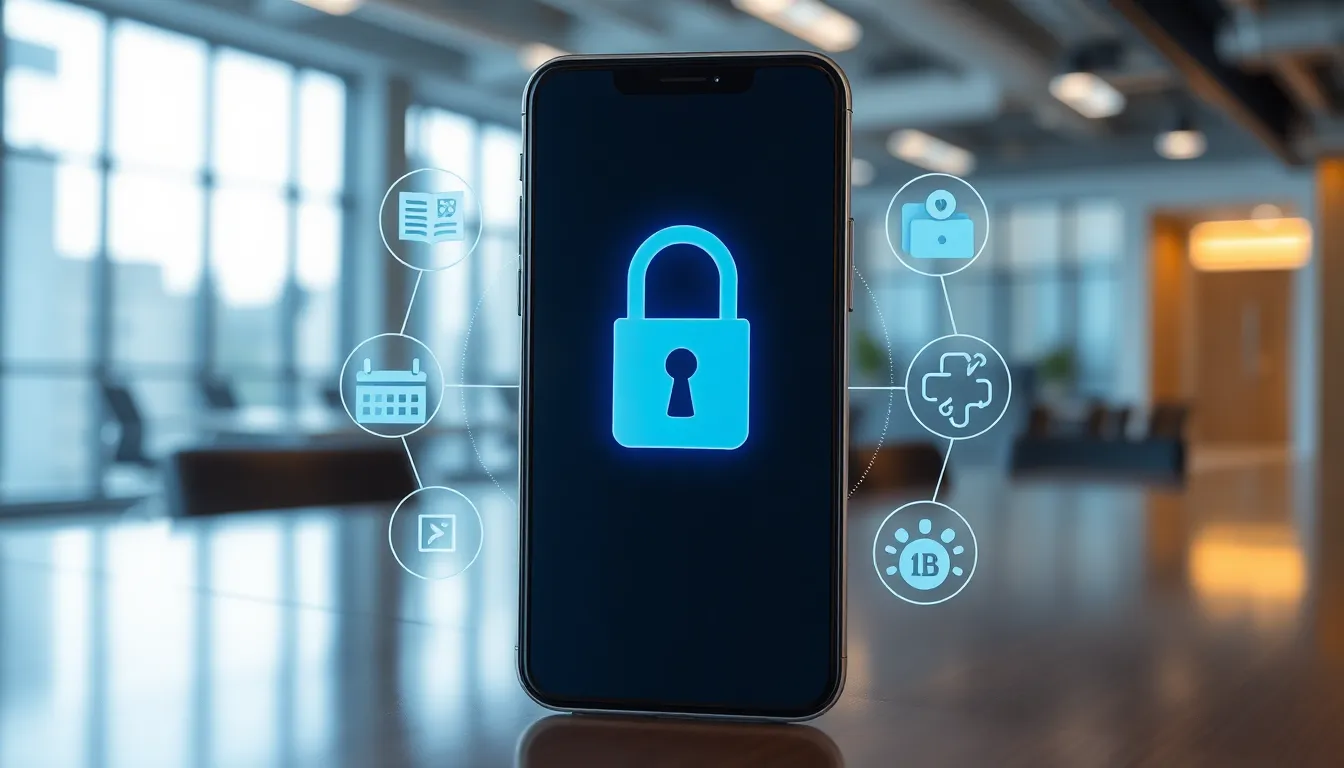In a world where everyone’s glued to their smartphones, mobile apps have become the lifeblood of daily life. From banking to dating, these tiny powerhouses hold a treasure trove of personal information. But wait! Just like that suspicious email from a “Nigerian prince,” not all apps are created equal. Some are more likely to steal your data than help you find the nearest pizza joint.
Table of Contents
ToggleOverview of Mobile Apps Security
Mobile apps security focuses on the measures and strategies designed to protect users’ data and the mobile devices themselves. Security breaches can vary, ranging from data theft to unauthorized access. Users often store sensitive information in apps, making it essential to implement robust security protocols.
Common threats include malware, which can infiltrate devices and compromise personal data. Phishing attacks target users through deceptive messages, often leading to the theft of login credentials. Ransomware can also lock users out of their devices or data until a ransom is paid.
Adopting specific best practices enhances mobile app security. Regular updates to apps and operating systems patch vulnerabilities. Strong passwords serve as the first line of defense, while enabling two-factor authentication adds an additional layer of security. Users should download apps only from trusted sources, like official app stores, to minimize risks.
Developers play a crucial role in ensuring app security. They need to conduct security testing throughout the development process. Implementing encryption algorithms protects data during transmission. Regularly reviewing security policies helps maintain high standards.
Industry regulations further influence mobile apps security. Compliance with standards, such as GDPR or HIPAA, demonstrates a commitment to protecting users’ privacy. Monitoring mobile app security metrics enables developers to assess their security measures’ effectiveness.
A proactive approach is essential in addressing mobile apps security challenges. Awareness of potential threats encourages users to be vigilant. Organizations benefit from investing in security training for employees, fostering a security-conscious environment.
Common Threats to Mobile Apps

Mobile apps face a variety of security threats that can compromise user data and device integrity. Understanding these threats is essential for maintaining security.
Malware and Viruses
Malware targets mobile devices through malicious applications. Many common types include spyware, which secretly gathers user data, and ransomware, which locks files until a ransom is paid. They often enter devices via third-party app stores or unverified downloads. Regular antivirus updates can help detect and eliminate these threats. Security features like app permissions enable users to restrict access to sensitive information, reducing risks.
Data Theft
Data theft occurs when attackers access sensitive information stored on a device. Personal data, financial information, and login credentials can be at risk from unsecured apps. Techniques such as network sniffing and man-in-the-middle attacks are often used to exploit weak connections. Use of encryption and secure protocols, such as HTTPS, significantly lowers the chances of data breaches. Users should also regularly review app permissions to ensure minimal access to private data.
Phishing Attacks
Phishing attacks manipulate users into revealing personal information through deceptive communications. These often take the form of fake emails or messages containing malicious links. Mobile users might encounter phishing attempts disguised as legitimate app notifications. Awareness of common phishing tactics is crucial in preventing data loss. Implementing two-factor authentication adds an extra layer of security against unauthorized access, enhancing overall app safety.
Best Practices for Securing Mobile Apps
Securing mobile apps requires a multi-faceted approach. Implementing best practices significantly reduces risks to user data.
Secure Coding Practices
Adhering to secure coding practices protects mobile apps from vulnerabilities. Developers should validate user inputs to prevent injection attacks. Implementing proper authentication methods enhances access control. Frequent code reviews identify potential security flaws before release. Additionally, utilizing open source libraries should be done cautiously. They can introduce risks if not properly vetted. Keeping coding standards updated helps maintain a strong security posture.
Regular Updates and Patching
Regular updates and patching play a crucial role in maintaining app security. Patching known vulnerabilities helps prevent exploitation by malicious actors. Users should enable automatic updates to ensure timely access to security fixes. Developers must monitor for new threats and respond rapidly with updates. Testing patches before release minimizes disruption and maintains user confidence. Fostering a routine for consistent updates reinforces overall app security.
Security Tools and Technologies
Security tools and technologies play a crucial role in safeguarding mobile apps from threats. These tools ensure user data remains protected and maintain the integrity of the applications.
Encryption Technologies
Encryption technologies secure data during transmission and storage. They convert sensitive information into unreadable formats, requiring decryption keys for access. Advanced Encryption Standard (AES) is commonly used, offering robust protection against unauthorized access. Implementing Transport Layer Security (TLS) helps secure communications between users and servers, preventing eavesdropping. Mobile apps can incorporate end-to-end encryption to safeguard messages and sensitive content, ensuring that only authorized users can access the information. Adopting these encryption methods mitigates risks associated with data theft, ensuring users’ personal information remains private.
Authentication Methods
Authentication methods verify user identities and restrict unauthorized access. Multi-factor authentication (MFA) represents a highly secure approach, combining something the user knows, like a password, with something the user has, such as a mobile device. Implementing biometrics, including fingerprint or facial recognition, enhances security and simplifies user access. Passwordless authentication eliminates the risk of weak passwords by using unique links or codes sent to registered devices. Employing strong password policies and encouraging users to create complex passwords significantly strengthens account security. By using varied authentication methods, mobile apps reduce the likelihood of unauthorized access and enhance overall security.
Future Trends in Mobile Apps Security
Innovations in mobile app security are essential as technology evolves rapidly. Artificial intelligence (AI) plays a pivotal role in identifying threats and enhancing security measures. Machine learning algorithms analyze user behavior to detect anomalies and potential attacks in real time.
Emphasis on biometric authentication methods continues to grow. Fingerprint scanning and facial recognition provide an additional layer of security to user accounts. These methods often reduce reliance on traditional passwords, which can be compromised easily.
Cloud-native security solutions are gaining traction in securing mobile applications. These solutions leverage cloud computing to enhance data security and enable real-time updates. Organizations find it easier to manage security protocols as they scale their applications in the cloud.
Decentralized identity management represents another emerging trend. This approach empowers users by giving them control over their personal data and how it is shared. User privacy improves dramatically, minimizing risks associated with centralized data storage.
Incorporating blockchain technology into mobile app security enhances transparency and trust. Blockchain allows secure transactions and immutable records, making it harder for attackers to manipulate data. Industries increasingly explore blockchain’s potential, especially in finance and healthcare sectors.
Compliance with regulations like GDPR and CPRA shapes the security landscape. Companies prioritize user data protection, adjusting their practices to align with evolving legislation. Fostering a privacy-first mindset becomes crucial for developers and users alike.
Overall, these trends underscore the importance of proactive security strategies in the mobile app ecosystem. With an ever-changing threat landscape, staying informed and adopting innovative solutions is vital for safeguarding users and their data.
Mobile app security is a critical aspect of modern digital life. As users increasingly rely on these applications for sensitive tasks, the potential risks cannot be overlooked. Implementing robust security measures is essential for both developers and users to protect personal data from evolving threats.
By adopting best practices like regular updates and strong authentication methods, individuals can significantly reduce their vulnerability to attacks. Developers must prioritize security testing and encryption to ensure their apps remain safe and compliant with industry standards.
As technology evolves, staying informed about emerging trends in mobile app security will be vital. A proactive approach fosters a safer environment for everyone, allowing users to enjoy the benefits of mobile apps with greater confidence.









